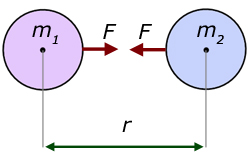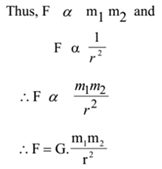Science > Physics > Gravitation >Newton’s Law of Gravitation
In this article, we shall study Newton’s law of gravitation, its universality, and universal gravitation constant.
Newton’s Law of Gravitation:
Statement:
Every particle of matter in the universe attracts every other particle of matter with a force which is directly proportional to the product of their masses and inversely proportional to the square of the distance between them.
Explanation:

Let ‘m1’ and ‘m2’ be the masses of two particles separated by a distance r as shown. According to Newton’s Law of gravitation, these particles will attract each other by a force ‘F’ such that

Where ‘G’ is a constant of proportionality and known as Universal gravitation constant. The value of ‘G’ in S.I. system is 6.673 10-11 N m2 kg-2 and in c.g.s. system is 6.673 10-8 dyne cm2 g-2.
The mathematical expression for the law of gravitation is sometimes written as

The negative sign indicates the force of attraction.
Newton’s Law of Gravitation in Vector Form:

Force of Gravitation:
The force of attraction between two material bodies in the universe is known as the force of gravitation.
If one of the body is the earth or some other planet or natural satellite then the force of gravitation is called the force of gravity.
Characteristics of Gravitational Force:
- The gravitational force between two bodies forms the action-reaction pair. The gravitational force between two masses is always that of attraction. If the first body attracts the second body with force F (direction of force from the second body to the first body), then the second body attracts the first body with equal force F (direction of force from the first body to the second body).
- The gravitational force between two masses is always acting along the line joining the centre of the two masses. Hence it is a central force.
- The gravitational force between two masses is independent of the medium between the two masses. It means the gravitational force between two masses is the same when they are kept in a vacuum or in water or in the air. This fact rules out the possibility of making gravity screens.
- The gravitational force between two masses is independent of their sizes or distribution of mass of the bodies.
- The gravitational force between two bodies does not depend upon the presence or the absence of other bodies.
- If the masses of the body are small, the gravitational force between them is negligible. If the masses are large like that of the sun and the earth, the gravitational force of attraction is considerable.
- The gravitational force between two bodies is called action – at – a distance type of interaction, because the two particles interact even though they are not in contact with each other. Thus gravitational force is a non-contact force.
- Gravitational force is a conservative force because the work done by the gravitational force is independent of the path between the initial and final position.
The universality of Newton’s Law of Gravitation:
Newton’s law of gravitation is also called as the universal law of gravitation because
- It is applicable to all material bodies irrespective of their sizes. It is applicable to very minute particles like atoms, electrons at the same time it is applicable to heavenly bodies like planets, stars etc.
- The law is applicable to all material bodies irrespective of the distance between them. It is applicable to interatomic distances at the same time it is applicable to stellar distances i.e. the distance between stars.
Evidence Supporting Newton’s Law of Gravitation:
- The Earth moves around the Sun under the gravitational influence of the Sun on the Earth.
- The Moon moves around the Earth under the gravitational influence of the Earth on the Moon.
- The high tide and low tide are caused due to the gravitational influence of the Moon on the Earth.
- The times of lunar eclipses and solar eclipses calculated on the basis of Newton’s law of gravitation are found to be approximately correct.
Difference Between Gravitation and Gravitational Force:
Gravitation is a natural phenomenon by which material objects attract one another. While the gravitational force is the force of attraction which keeps two bodies in the universe bonded together.
Factors Affecting the Gravitational Force Between Two Bodies:
- The gravitational force of attraction between two bodies is directly proportional to the product of masses. If the distance between two masses is constant, then an increase in the mass of one of the two or of both increases the gravitational force of attraction between the two bodies.
- The gravitational force of attraction between two bodies is inversely proportional to the square distance between the two bodies. If the masses are kept constant, then the increase in distance between the two bodies decreases the gravitational force of attraction between the two bodies.
- The gravitational force between two masses is independent of the medium between the two masses.
- The gravitational force between two bodies does not depend upon the presence or the absence of other bodies.
S.I. Unit of G:
By Newton’s law of gravitation

The SI unit of constant of gravitation is N m2 kg-2 and c.g.s. unit is dyne cm2 g-2.
Dimensions of G:
By Newton’s law of gravitation

Hence the dimensions of universal gravitation constant are [M-1 L3 T-2]
Definition of G:
The gravitational force between two point masses ‘m1’ and ‘m2’ separated by distance ‘r; is given by

Let r = 1 unit, m1 = m2 = 1 unit, then G = F
Hence, the universal gravitational constant is the numerical value of the force between two unit masses kept at a unit distance from each other.
The value of G is very small and gravitational forces are small unless the masses of the two attracting bodies are large. If the value of G becomes 100 times its present value, then the earth’s attraction would be so large that we would be crushed to the earth. If the value of G becomes 1/100 times its present value, then we would be able to jump from a multi-story building.
Principle of Superposition of Forces:

Next Topic: Numerical Problems on Newton’s Law of Gravitation
